Me too! And I stand with admiration of Andy's unquenchable and inspirational searching.for the best...thank you Andy!I think Andy has said many times that his circuits are power stage drivers. Actually I don’t think he uses a preamp? I’ve learned a lot from all the things he’s tried and value his opinion very much.
Best, Robert
Those of you who use one 26 tube per channel without NFB, have you ever measured FFT of output (say 1k frequency signal input, 2v rms output into 100k load)? How much is your 2nd harmonic? How many -dB should be expected?
The spectrum mainly depends on tube's condition.Those of you who use one 26 tube per channel without NFB, have you ever measured FFT of output (say 1k frequency signal input, 2v rms output into 100k load)? How much is your 2nd harmonic? How many -dB should be expected?
Rare DH tubes are very sensitive to radiated hum/EMF/RFI. Some tube works like antenna, some -more or less- insensitive for this.
There may be a difference in 50Hz/60Hz spectrum even 20-30dB!!!
This is more important (for tone), than tube's own distortion.
This is my "best" #26 tube (1V in, CCS loaded globe Majestic #26, 100k load).
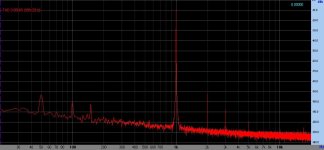
This is another Majestic:
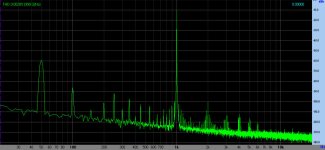
What signal source do you guys use? I have a old tek signal generator. Taking 1k hz signal for example, 2nd harmonic is about -50bd and its 4th one is slightly worse than 2nd harmonic- based on FFT of my oscilloscope…
Best to use your music playback DAC. No harmonics at -100dB or even lower (ESS DACs).
You can generate WAV files to play the test signal. Audacity should do this: Foss application.
You can generate WAV files to play the test signal. Audacity should do this: Foss application.
Victor's fixed (1k, 10k) spec. sine generators for THD measuring.What signal source do you guys use? I have a old tek signal generator. Taking 1k hz signal for example, 2nd harmonic is about -50bd and its 4th one is slightly worse than 2nd harmonic- based on FFT of my oscilloscope…
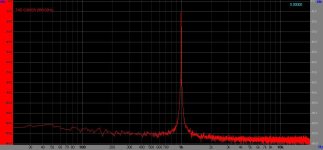
For anything (for example bandwidth measurement) else EMU0404 USB soundcard.... or old Heathkit IG-18 generator.
... my very lose rule-of-thumb is that as long as the third-harmonic of the system (preamp and power-stage) is more than -70dB under the fundament at 1 watt, one is good to go.
I haven't used a 26 line stage for a while so I thought I'd revisit it. It's configured in filament bias as usual for my DHT builds. It functions as the driver stage for EL12n outputs making a 2 stage SE amp. Schematic attached. I've just fired it up so there may be revisions.
Plus points - lovely tonality, especially on voices. This was always the type 26's strength. Very nice overall on classical music and opera.
Points to look at - the bass response is a little boomy and could be tighter. I'm just guessing here, but I think the issue may be that I need a larger anode resistor. I have a HT of 300V so this would mean reducing the current from the present 7.3mA. With 6mA the anode resistor would be 25K, which would probably be a step in the right direction. A 27K resistor would be 5.6mA. Bigger still would no doubt be good.
This could also mean a higher HT, or using a plate choke, which I do have. The tonal quality of the 26 makes a good solution worth it.
Comments and suggestions?
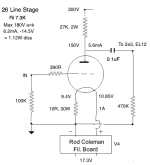
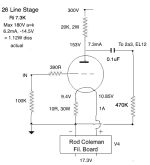
Plus points - lovely tonality, especially on voices. This was always the type 26's strength. Very nice overall on classical music and opera.
Points to look at - the bass response is a little boomy and could be tighter. I'm just guessing here, but I think the issue may be that I need a larger anode resistor. I have a HT of 300V so this would mean reducing the current from the present 7.3mA. With 6mA the anode resistor would be 25K, which would probably be a step in the right direction. A 27K resistor would be 5.6mA. Bigger still would no doubt be good.
This could also mean a higher HT, or using a plate choke, which I do have. The tonal quality of the 26 makes a good solution worth it.
Comments and suggestions?


Update:
I changed the anode resistor to 27.5K and the bass has tightened up a bit, though it's still a touch exaggerated. I think the resistor could be bigger again. Looks like I need a HT of 350V or more. I've been using a 47 stage recently and the bass with that is tight and balanced, but that has a Rp of around 3.2K in triode where the 26 is around 7.3K. I'm also putting 10mA through the 47.
I was contemplating using the 26 instead of the 47 into a Lundahl LL1660/18mA interstage phase splitter. Looks like the impedance for the input there is 42H in Alt-V. I'm wondering how that would work.
https://www.lundahltransformers.com/wp-content/uploads/datasheets/1660.pdf
I changed the anode resistor to 27.5K and the bass has tightened up a bit, though it's still a touch exaggerated. I think the resistor could be bigger again. Looks like I need a HT of 350V or more. I've been using a 47 stage recently and the bass with that is tight and balanced, but that has a Rp of around 3.2K in triode where the 26 is around 7.3K. I'm also putting 10mA through the 47.
I was contemplating using the 26 instead of the 47 into a Lundahl LL1660/18mA interstage phase splitter. Looks like the impedance for the input there is 42H in Alt-V. I'm wondering how that would work.
https://www.lundahltransformers.com/wp-content/uploads/datasheets/1660.pdf
Andy,
Try to lower operating point. 150+ V, and 6+ mA is too high, if you use resistive anode load.
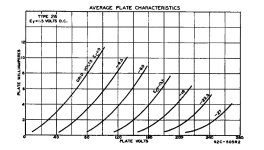
My #26 preamp schematics
https://www.diyaudio.com/community/threads/26-pre-amp.151421/page-254#post-6470230
Try to lower operating point. 150+ V, and 6+ mA is too high, if you use resistive anode load.

My #26 preamp schematics
https://www.diyaudio.com/community/threads/26-pre-amp.151421/page-254#post-6470230
It functions as the driver stage
I find it difficult to call something with an output resistance in the multi kiloohm range a driver. Or use it as a standalone preamp. It is certainly an excellent low distortion voltage gain stage if one can restrain the microphony, but call it a driver?
Why? The book maximum operating point is 180V, 6.2mA, -14.5V. That's 1.12W dissipation. Since we don't have a quoted dissipation in the data I'm going on that figure. I'm just at 1W so inside the maximum.Andy,
Try to lower operating point. 150+ V, and 6+ mA is too high, if you use resistive anode load.
View attachment 1209896
My #26 preamp schematics
https://www.diyaudio.com/community/threads/26-pre-amp.151421/page-254#post-6470230
The 7.3K Ra certainly needs some attention, as analog says. I have this stage in a separate box so I'm using short cables made from twisted pairs to connect it to the output stage. The output stage is EL12n which is mu=18 in triode and a tonality I like a lot. The cathode voltage is just 11.7V so very easy to drive. I'm getting good sound out of this combination.
It's not dissipation problem.
#26 (IMO) sensitive to operating point, the tone is varying if you chose another operating point ... and it's tube (manufacturer, condition) dependent.
BTW, your bias voltage shows, that R.C regulator current is below 1A (0.94A?), so tube a little underheated.
#26 (IMO) sensitive to operating point, the tone is varying if you chose another operating point ... and it's tube (manufacturer, condition) dependent.
BTW, your bias voltage shows, that R.C regulator current is below 1A (0.94A?), so tube a little underheated.
<<#26 (IMO) sensitive to operating point, the tone is varying if you chose another operating point ...
What's your preferred range, Bela? From what to what?
What's your preferred range, Bela? From what to what?
Preferred range about 5..6mA, 140..170V, but I always use CCS/gyrator.
It's specific to my - currently used - tubes (globe F.A.D.A):
5.9mA (CCS), 167V on the anode, 10.1V on 10R filament bias resistor (about -10.9V bias).
The choosing of operating point mostly depends of tube's condition. These tubes are almost hundred years old, so condition isn't consistent.
The most "hectic" tubes are globe Cunninghams, the most consistence are Philco and ST type tubes.
If you change tubes (for example from ST one to globe), the previously settings will work, but "tone" also change. Fine tuning may be necessary.
It's specific to my - currently used - tubes (globe F.A.D.A):
5.9mA (CCS), 167V on the anode, 10.1V on 10R filament bias resistor (about -10.9V bias).
The choosing of operating point mostly depends of tube's condition. These tubes are almost hundred years old, so condition isn't consistent.
The most "hectic" tubes are globe Cunninghams, the most consistence are Philco and ST type tubes.
If you change tubes (for example from ST one to globe), the previously settings will work, but "tone" also change. Fine tuning may be necessary.
Thanks Bela - very informative. I have a bunch of type 26, ST and globe, so I can do some tube rolling. I think this 26 stage is staying in my system for a while. I'm glad I "rediscovered" the 26. This was the first DHT I used back in 2009. I've been liking the 47, but the 26 is a true triode.
My present operating point of 150V, 5.6mA, -10V is in your ballpark I think, with 27.6K anode resistor. I prefer resistors to CCS though, I find them smoother - I listen to a lot of opera and classical.
My present operating point of 150V, 5.6mA, -10V is in your ballpark I think, with 27.6K anode resistor. I prefer resistors to CCS though, I find them smoother - I listen to a lot of opera and classical.
I tried a pair of globes but found the sound less interesting than the ST, which were brighter and more focussed. I know globes have a bit of an aura about them, but they're not necessarily better.
What have been your experiences between globes and ST?
What have been your experiences between globes and ST?
I prefer the 01A to the 26 in my preamp because of the increased details the 01A presents.
For both 26 and 01A, I find the balloon/globe types better sounding in my system. By better I mean fuller, more harmonic and less bright.
For both 26 and 01A, I find the balloon/globe types better sounding in my system. By better I mean fuller, more harmonic and less bright.
- Home
- Amplifiers
- Tubes / Valves
- #26 pre amp